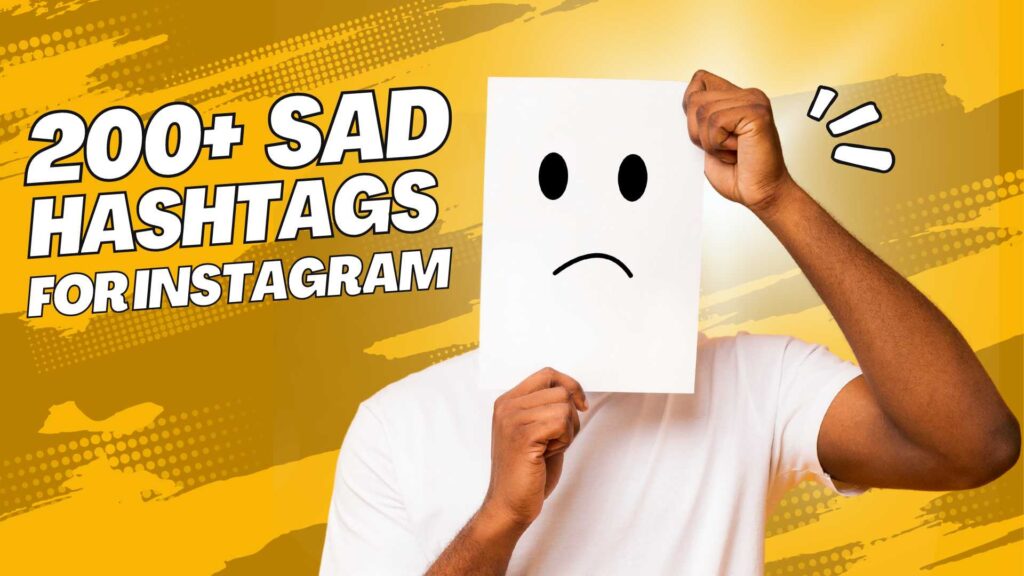200+ Sad hashtags for instagram

On the virtual space, Instagram has grown to be a worldwide phenomenon—a digital canvas for millions of people to share their lives in photos and videos. Hashtags are crucial navigation tools in this vast sea of visual content by which users discover and connect with people who share similar interests, experiences, and feelings. Among the many hashtags used today, sad hashtags for Instagram have become a very strong way by which a user can share his or her dark moment and relate to the communities in the online world.
Sad hashtags for Instagram reflect a growing trend in the emotional transparency of social media platforms. Nowadays, people are more comfortable sharing not only their highlight reels but also ups and downs. This shift created space for authentic expression and mutual support, especially in relation to feelings of sadness, loneliness, or depression.
The sad hashtags on Instagram offer several functionalities. They help the user organize his content so that like-minded people who feel the same way can find it. On the other hand, these hashtags can also be used to plead for help, facilitate the expression of strong emotions, or even create awareness about mental health issues.
What Are Sad Hashtags?
Sad Instagram hashtags are ways through which a user can express and share their sour feelings across the platform. Hashtags act as digital markers which people use to label their posts so that they can connect with other persons who might have the same feelings. The spectrum for sad hashtags on Instagram can be anything from mild melancholy to deep despair.
Some common sad hashtags for Instagram include:
– #Sad: A straightforward expression of general sadness
– #Lonely: Conveying feelings of isolation or disconnection
– #Heartbroken: Often used for relationship-related pain
– #Depressed: Indicating a more severe state of sadness
– #Hurt: Expressing emotional or psychological pain
Sad hashtags for Instagram serve multiple purposes
- Self-expression: Users can articulate their emotions through these tags
- Community building: People can find others with similar experiences
- Seeking support: Tags can attract empathetic comments or messages
- Raising awareness: Some use sad hashtags for Instagram to highlight mental health issues
Remember, though, sad Instagram hashtags can be used not to reserve that space as a form of indirect emotional outburst or not to replace professional help towards people with serious or persistent negative emotions. There are sad Instagram hashtags that might be made a little more specific or personalized to give their emotional expression a bit more variety or, if anything, just to stand out among the millions of posts on the platform.
200+ Sad hashtags for Instagram
1. General Sadness Hashtags:
These tags express overall feelings of sadness without specifying a particular cause. They capture a broad range of melancholic emotions and low moods. General sadness hashtags convey a state of unhappiness, sorrow, or emotional pain without pinpointing a specific trigger or situation.
- #Unhappy
- #Gloomy
- #Melancholy
- #Sorrowful
- #BlueFeeling
- #Downcast
- #Disheartened
- #Despondent
- #Dejected
- #Forlorn
- #Heartache
- #Somber
- #Tearful
- #Woeful
- #Desolate
2. Relationship and Heartbreak Hashtags:

These tags focus on sadness stemming from romantic relationships, including breakups, unrequited love, and relationship struggles. Relationship and heartbreak hashtags express emotional pain related to romantic connections, often involving loss, rejection, or disappointment in love.
- #Breakup
- #LoveHurts
- #Betrayed
- #MovingOn
- #Heartbroken
- #UnrequitedLove
- #EndOfRelationship
- #ToxicLove
- #LostLove
- #RejectedHeart
- #BrokenPromises
- #LonelyHeart
- #FallingOutOfLove
- #TrustIssues
- #ShatteredDreams
3. Loneliness Hashtags:

They convey emotions of being alone, isolated, or disconnected from others quite often, with added feelings of emptiness or abandonment. Loneliness hashtags can convey the state of feeling lonely, companionless, or socially isolated, even when in a crowd of people.
- #Alone
- #Isolated
- #Forgotten
- #Disconnected
- #Solitude
- #Abandoned
- #LonelyNights
- #SociallyIsolated
- #Outcasted
- #Neglected
- #EmptyRoom
- #NoFriends
- #Alienated
- #Lonesome
- #Detached
4. Mental Health Awareness Hashtags:

These are tags related to general mental health issues, be they about awareness, reduction in stigmatization, and eventually eliciting support toward realization. Mental health awareness hashtags discuss the issues of psychological well-being, emotional struggles, and mental disorders in a bid to foster comprehension and support.
- #Depression
- #Anxiety
- #MentalHealth
- #PTSD
- #BipolarDisorder
- #EatingDisorder
- #Schizophrenia
- #OCD
- #PanicAttacks
- #SelfHarm
- #Suicidal
- #MentalIllness
- #TherapyHelps
- #EndTheStigma
- #MentalHealthMatters
5. Loss and Grief Hashtags:

These tags show sadness related to the loss of someone or something important, be it death, the end of relationships, or other general life changes. Hashtags about loss and grief reflect the emotional pain and sorrow over the absence or end of something or someone valuable in one’s life.
- #Grief
- #Loss
- #MissingYou
- #GoneTooSoon
- #Bereavement
- #InMemoriam
- #Mourning
- #BrokenHeart
- #EmptySpace
- #Remembrance
- #FinalGoodbye
- #NeverForgotten
- #LifeChanged
- #CopingWithLoss
- #ForeverMissed
6. Emotional State Sad Hashtags for Instagram

- #Sad
- #AngerIssues
- #Sadness
- #HappyVibes
- #StressRelief
- #LoveStruck
- #Unhappy
- #Miserable
- #Gloomy
- #Melancholy
- #Sorrowful
- #Frustrated
- #GratefulHeart
- #LonelyNights
- #Excited
- #PeacefulMind
It’s important to note that while these hashtags can be used to express genuine feelings and connect with others experiencing similar emotions, they should not replace seeking professional help if struggling with persistent sadness or mental health issues.
Here are some alternatives to sad hashtags for Instagram:
- #Hope
- #Growth
- #Resilience
- #SelfLove
- #PositiveVibes
- #Healing
- #Strength
- #NewBeginnings
- #Gratitude
- #SelfImprovement
These sad hashtag alternatives, if used on Instagram, will let you find supportive communities and bring positive content into your feed. That said, it is good to give way to the feeling of negativity, but documenting and being in the habit of negative content most times might keep you on a single way trip of negativity. If you balance your social media presence with more uplifting tags, you will be creating a much healthier online life.
Remember, it’s not about suppression or denial; the effort should be to express and deal with them properly. Moving away from some of those sad hashtags for Instagram toward some more positive alternatives might be a tiny step into taking control of your emotional well-being on social media.
Sad Hashtags For Instagram: Using Them Responsibly
1. Be true: Use sad hashtags on Instagram that reflect the real feelings. authentic sad hashtags for Instagram will enable real connections with your followers to be established. One should avoid these tags only when the purpose is other than seeking attention or engagement.
2. Pair some positivity: While it is always acceptable to bring out your feelings of sadness with the help of sad hashtags for Instagram, try balancing them by placing more hopeful or resilient tags right next to them. In this way, you would balance sad hashtags for Instagram such as #Heartbroken or #Lonely with tags like #Healing, #GrowingStronger, or #OneStepAtATime. Doing this depicts the outlook that though you are acknowledging your feelings, simultaneously, you are promoting emotional growth.
3. As a stepping stone to support: If you’re coming back to sad hashtags on Instagram time and again, it’s actually a very good indication that you need more support. Don’t be afraid to go out and seek help from friends, family, or mental health professionals. After all, while sad hashtags for Instagram can give you a voice and an outlet, they are not necessarily real-world surrogate support and professional advice.
4. Interact with others: Sad hashtags on Instagram may help you come across people going through the same emotions. That is comforting, but beware slipping back into negative thoughts about yourself. Make use of such connections to get support and strategies to cope, rather than to further fuel feelings of sadness.
Remember, while sad hashtags for Instagram are at times helpful in self-expression and connection, they should be used only as part of a holistic approach toward emotional well-being. If you notice yourself turning to sad hashtags for Instagram all the time, then perhaps it is time to seek other support and find ways to cope that are much healthier for your well-being.
Explore some informational Blogs
Conclusion
Sad hashtags on Instagram are a part of something bigger: the need for emotional expression and connection in the digital age. While these hashtags can provide a sense of community and validation, it’s important to be conscious and balanced with them. Systematic over-reliance on the sad hashtags on Instagram might speak to the need for support of a more significant nature than social media.
This brings into the undeniable fact that we, as users, should be creating a much healthier online environment through sharing diversified content and by being mindful of the emotions we share and consume. Always remember that social media itself, with the sad hashtags on Instagram, should not replace real-life interaction or professional help when necessary.
If we keep this in mind, the sad hashtags on Instagram can turn into a corrective for authentic attachment and help in resilience and positivity in our online and offline lives. At least, what we need is a well-balanced digital presence—one acknowledging the fuller range of our emotional experience without getting submerged by negativity.
